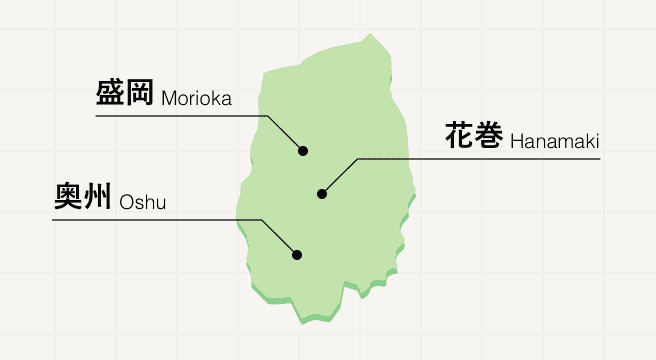Other Historic Site/Building Spots in Hanamaki / Tono Area
Area
-
-
Iwate
-
-
Iwate

-
-
Other Historic Site/Building
-
Other Historic Site/Building
Category


-
- Gohyaku Rakan
- Travel / Tourism
- Iwate Tono-shi Ayaoricho Nissato
- 500 statues of rakan Buddhist disciples made from natural rock. They were carved over a several year period about 200 years ago by the priest Gizan of Daijiji Temple as memorials to people who died from a famine that hit Tohoku. Large and small pieces of granite were placed around the forest, and he proceeded to carve the images from them. Moss has covered the statues over the years, leaving them integrated with the natural landscape. To get there you can climb a trail starting beside Atago Shrine, or you can drive up.
-
- Dannohana
- Travel / Tourism
- Iwate Tono-shi Tsuchibuchicho Yamaguchi 2-chiwari
- An area near the childhood home of Sasaki Kizen, a folk tale scholar and Tono City native. Today there's a public cemetery on top of a hill, along with Kizen's grave. According to the Legends of Tono, when the graveyard was made, a large bottle was found. This angered the village elders, so it was re-buried. It's also said to be a graveyard for those who died at Dendera Field where old villagers went at the end of their lives.
-
- Kitsune no Sekisho
- Travel / Tourism
- Iwate Tono-shi Tsuchibuchicho Tsuchibuchi
- There are several stone statues of foxes on the outskirts of Tono. This one is on a street between the Kogarase River and National Route 340. Legend says that one day when a man passed through the neighborhood, he was tricked by a fox who turned itself into a young maiden. A sign board tells the story so you can experience the tale for yourself. The statue is located on a small hill with a nice view overlooking the countryside with the mountains in the distance.
-
- Takamura Sanso
- Travel / Tourism
- Iwate Hanamaki-shi Ota 3-85-1
- A mountain cottage located about 20 minutes by car from JR Hanamaki Station. It's where Takamura Kotaro spent seven years starting in 1945 and is adjacent to the Takamura Kotaro Museum. Built with wood gathered by villagers who admired Takamura, it has outer walls and another roof protecting the original house. The villa is about 25 square meters including the dirt floor, and it's built so roughly that snow blows in during the winter. It is preserved just as it was when Takamura lived there, with elements such as his self-portrait and a window in the shape of the Chinese character for light on the bathroom door.
-
- Monument to Kenji Miyazawa (Ame ni mo Makezu Monument)
- Travel / Tourism
- Iwate Pref. Shimoheiguntanohatamura Raga 3
- This monument is especially valuable, among all the many Kenji Miyazawa monuments, for the section of his famous poem “Ame ni mo Makezu” engraved on in in the handwriting of Kotaro Takamura. It was erected in 1936, but since some words were accidentally omitted, it was re-engraved in 1944. Crowds of people from all over Japan gather here every year on September 21st, the anniversary of Miyazawa’s death. It’s a 10 minute drive from Tohoku Expressway Hanamaki Minami Interchange.
-
- Omine Mine Ato
- Travel / Tourism
- Iwate Tono-shi
-
- Tourist Yana
- Travel / Tourism
- Iwate Hanamaki-shi
-
- Former Kohara Family's Residence
- Travel / Tourism
- Iwate Hanamaki-shi
-
- Seishin Nikonohaka
- Travel / Tourism
- Iwate Pref. Tonoshi Matsuzakichoukoukouji
Iwate Areas

A northern Tohoku prefecture promising peace and quiet, Iwate is sparsely populated, replacing people with snow-capped mountains, history-rich sites, and fields of crops that are to thank for the region’s delicious local cuisine. Meander along the three-city Golden Route, where you’ll visit the grand Buddhist temples of Hiraizumi and the Tono folk villages before tasting the three famed noodle dishes of Morioka.
Best of Iwate
Search by Region
-
- Hokkaido / Tohoku
- Hokkaido
- Aomori
- Iwate
- Miyagi
- Akita
- Yamagata
- Fukushima
-
- Kanto
- Ibaraki
- Tochigi
- Gunma
- Saitama
- Chiba
- Tokyo
- Kanagawa
-
- Koshinetsu / Hokuriku
- Niigata
- Toyama
- Ishikawa
- Fukui
- Yamanashi
- Nagano
-
- Tokai
- Gifu
- Shizuoka
- Aichi
- Mie
-
- Kinki
- Shiga
- Kyoto
- Osaka
- Hyogo
- Nara
- Wakayama
-
- Chugoku
- Tottori
- Shimane
- Okayama
- Hiroshima
- Yamaguchi
-
- Shikoku
- Tokushima
- Kagawa
- Ehime
- Kochi
-
- Kyushu / Okinawa
- Fukuoka
- Saga
- Nagasaki
- Kumamoto
- Oita
- Miyazaki
- Kagoshima
- Okinawa
















